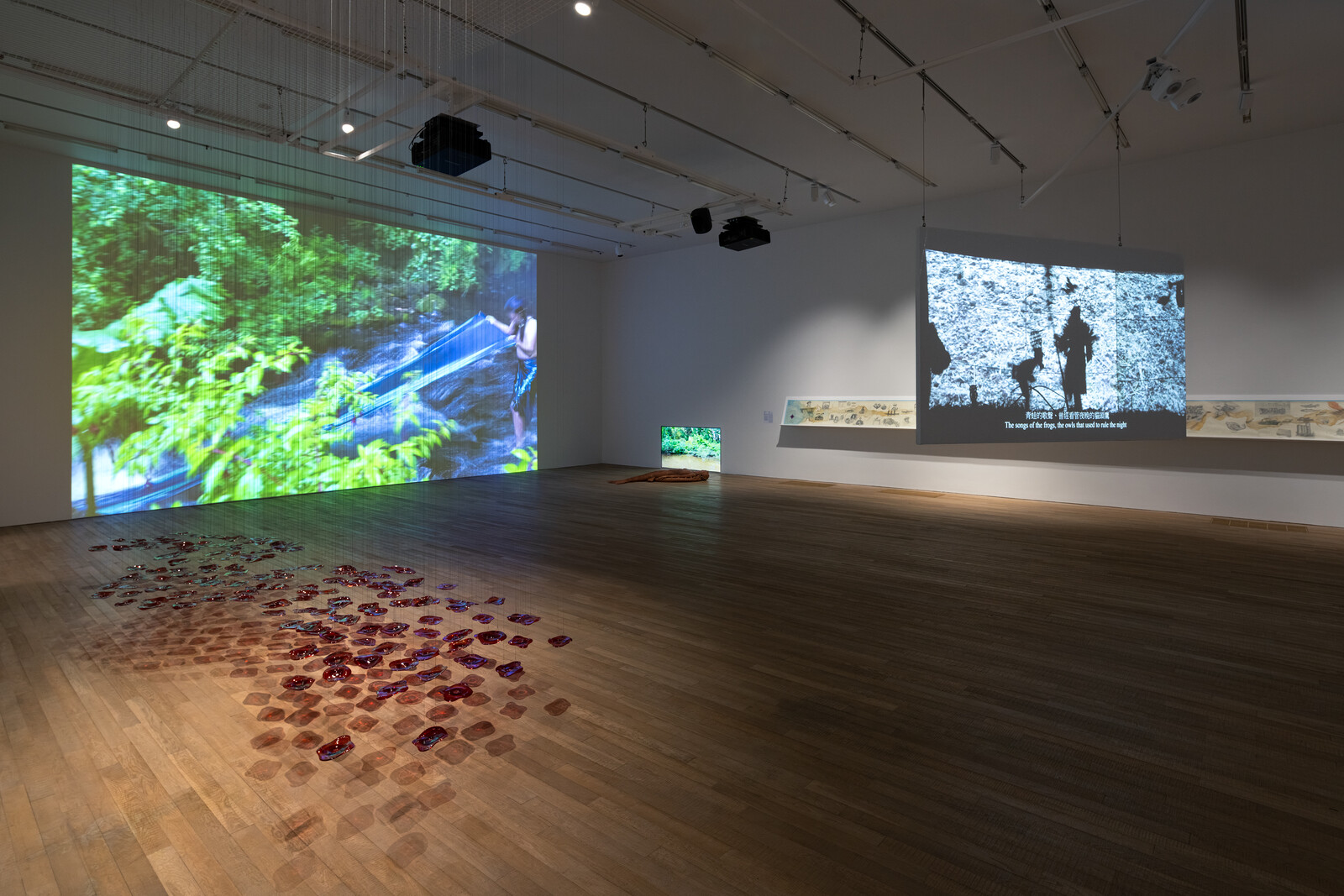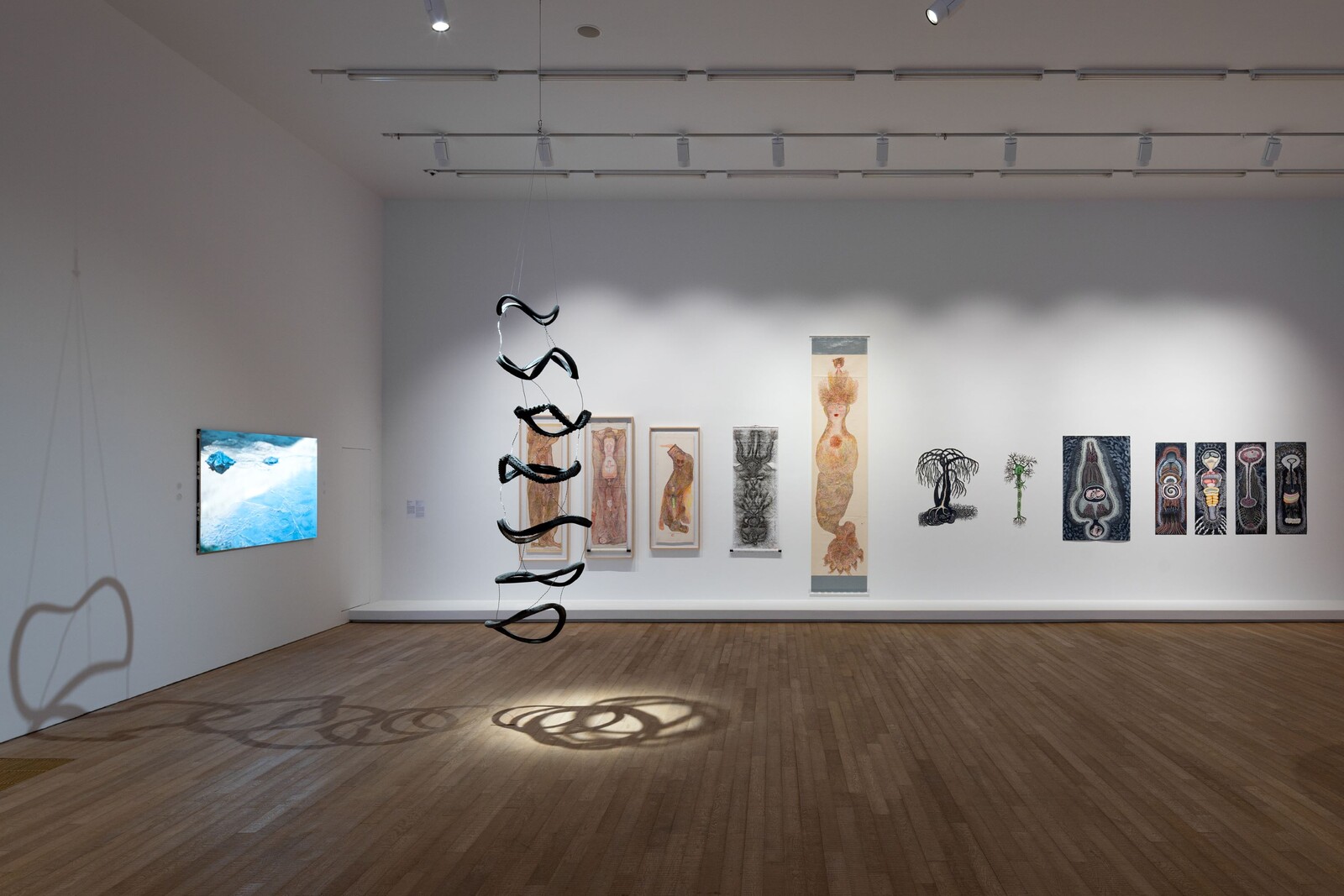Of all the works in this gathering of cosmological and ecological perspectives, one is anchored directly to the exhibition title. Two moon gates open up the wooden frame enclosing Candice Lin’s Kiss under the tail (all works 2023 unless otherwise stated), where floorspace padded with tatami mats hosts ceramic cats, one with a house for a head, and an indigo-dyed carpet whose patterning replicates a nineteenth-century diagram of a castration by a western missionary who studied eunuchs in China. These gates, and the transformational space they envelope, reference a central location in Tsui Hark’s 1993 movie, Green Snake, a retelling of an ancient Chinese folktale about two female snake demons who endeavored to become human. In the film, the single-minded White Snake pursues the love of a studious male, while the free-wheeling, shapeshifting Green Snake tries to understand the desire that drives her centuries-long companion to her doom. In the end, Green Snake rejects the human world with its apocalyptically heteronormative devotions and questionably immutable morals, realizing she had known love as an affirmation of life all along. So she returns to the water, or rather to nature; an idea that runs through this show.
Projected onto a massive wall in the first gallery, for example, is Seba Calfuqueo’s video TRAY TRAY KO (2022), which shows the artist walking along the Río Palguín in Chile, carefully pulling a long electric blue sash behind them until they walk into a trayenko, the Mapuche name for a waterfall, around which healing plants grow. Cecilia Vicuña’s video Quipu Mapocho (2016–17) extends Calfuqueo’s act of recuperative return in the same gallery. Tangles of Vicuña’s red-dyed unspun wool “quipoems”—referring to Quipu, the pre-Colombian form of writing by tying cords into knots—appear in the waters and on the banks of another river in Chile, the Mapocho. Contaminated by sewage and industrial waste, and haunted by the bodies dumped here during the Pinochet dictatorship, Vicuña has called the Mapocho the river of death. Its history of environmental degradation at the hands of colonizers, industrialists, and neoliberals is expanded nearby in Adriana Bustos’s 10-meter-long scroll depicting the rivers of the Americas, Afluentes Sudamericanos Carta de navegación. Annotations describe events that have occurred around these waters, including the construction of the first European fortification in modern-day Argentina in 1527.
Dima Srouji’s single-channel video, She Still Wears Kohl and Smells Like Roses, and Red River, an assembly of red glass petals hung flatly to mimic a river’s flow, expand the geographical frame. Both works reference the Belus River in Palestine, whose waters have been contaminated by an Israeli weapons manufacturer located close to its banks. The video describes a cycle of extraction that the Palestinians have long been subjected to, in which Israeli weapons kill Palestinians whose graves are later exhumed during further Israeli incursions. But as subtitles suggest, resistance is everywhere. From the displaced remnants of the land’s ancient past, like an excavated figurine of the goddess Astarte now holding “the front lines” in a London museum, to the Palestinian grandmothers who make pastries the same way they nurture the earth. “We know our land at a tiny scale, microscopic,” the text on screen proclaims: “it knew us well, too.”
Across “Green Snake,” time is cyclical when understood in profoundly material terms: a force not unlike the rain-river depicted in Karan Shrestha’s ink painting Valvala. A swirl of plants and beings move over the paper, who emanate from the cloud-lake in the sky that the Newar people of the Kathmandu Valley see as the source of all earthly waters. This ancient understanding of nature as both life source and living container receives a twenty-first century update in Stephanie Comilang and Simon Speiser’s poetic documentary Piña, Why is the Sky Blue? (2021). In one segment, Alba Pavón, an Afro-Ecuadorian organizer of the Black Women’s Movement, calls her people children of water, describing the knowledge of nature that ensured the survival of the formerly enslaved and their descendants in Ecuador. In another, Ciber Amazonas activists describe the internet and new media as tools to transmit and archive Indigenous histories for future generations, framing ancestral knowledge and the natural world from which it derives as the original cloud technology.
Natasha Tontey’s video installation Of Other Tomorrows Never Known, installed in the second gallery, extends these ideas by looking at Minahasan cosmology from Indonesia’s North Sulawesi. The video, which begins by describing astronomical knowledge as “the first technological application for the people,” tells the story of Makatana, “a manifested artificial intelligence encrypted by the supreme cosmic being,” which writer Nuraini Juliastuti describes as “the spirit, collective principles, and technologies for life.” An aesthetic cross between a German Expressionist gothic horror and a camp, psychedelic Technicolor B-movie, the film leans into the framing of Indigenous stories under colonialism and Christianity as scandalously taboo. What emerges, as with “Green Snake” as a whole, is a reclamation of the living world as a transgressive cult phenomenon worth following.






